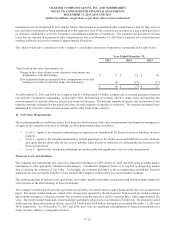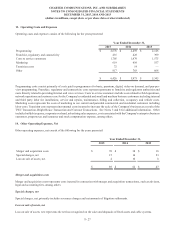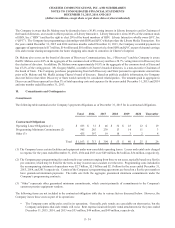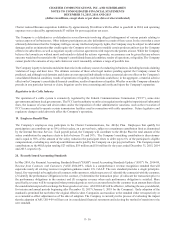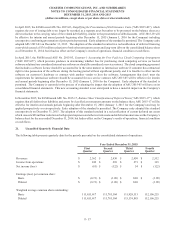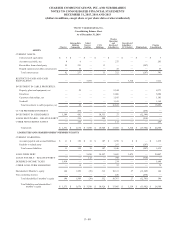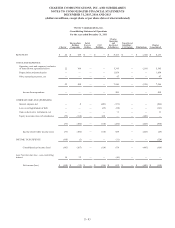Charter 2015 Annual Report Download - page 132
Download and view the complete annual report
Please find page 132 of the 2015 Charter annual report below. You can navigate through the pages in the report by either clicking on the pages listed below, or by using the keyword search tool below to find specific information within the annual report.CHARTER COMMUNICATIONS, INC. AND SUBSIDIARIES
NOTES TO CONSOLIDATED FINANCIAL STATEMENTS
DECEMBER 31, 2015, 2014 AND 2013
(dollars in millions, except share or per share data or where indicated)
F- 35
• The Company pays franchise fees under multi-year franchise agreements based on a percentage of revenues generated
from video service per year. The Company also pays other franchise related costs, such as public education grants, under
multi-year agreements. Franchise fees and other franchise-related costs included in the accompanying statement of
operations were $212 million, $208 million, and $190 million for the years ended December 31, 2015, 2014, and 2013
respectively.
• The Company also has $67 million in letters of credit, primarily to its various worker’s compensation, property and
casualty, and general liability carriers, as collateral for reimbursement of claims.
Litigation
In 2014, following an announcement by Comcast and TWC of their intent to merge, Breffni Barrett and others filed suit in the
Supreme Court of the State of New York for the County of New York against Comcast, TWC and their respective officers and
directors. Later five similar class actions were consolidated with this matter (the “NY Actions”). The NY Actions were settled in
July 2014, however, such settlement was terminated following the termination of the Comcast and TWC merger in April 2015.
In May 2015, Charter and TWC announced their intent to merge. Subsequently, the parties in the NY Actions filed a Second
Consolidated Class Action Complaint (the “Second Amended Complaint”), removing Comcast and Tango Acquisition Sub, Inc.
as defendants and naming TWC, the members of the TWC board of directors, Charter and the merger subsidiaries as defendants.
The Second Amended Complaint generally alleges, among other things, that the members of the TWC board of directors breached
their fiduciary duties to TWC stockholders during the Charter merger negotiations and by entering into the merger agreement and
approving the mergers, and that Charter and its subsidiaries aided and abetted such breaches of fiduciary duties. The complaint
sought, among other relief, injunctive relief enjoining the stockholder vote on the mergers, unspecified declaratory and equitable
relief, compensatory damages in an unspecified amount, and costs and attorneys’ fees.
In September 2015, the parties entered into a memorandum of understanding (“MOU”) to settle the action. Pursuant to the MOU,
the defendants issued certain supplemental disclosures relating to the mergers on a Form 8-K, and plaintiffs agreed to release with
prejudice all claims that could have been asserted against defendants in connection with the mergers. The settlement is conditioned
on, among other things, consummation of the transactions between TWC and Charter, and must be approved by the New York
Supreme Court. In the event that the New York Supreme Court does not approve the settlement, the defendants intend to vigorously
defend against any further litigation.
In August 2015, a purported stockholder of Charter filed a lawsuit in the Delaware Court of Chancery, on behalf of a putative class
of Charter stockholders, challenging the transactions between Charter, TWC, A/N, and Liberty Broadband announced by Charter
on May 26, 2015 (collectively, the “Transactions”). The lawsuit names as defendants Liberty Broadband, Charter, the board of
directors of Charter, and New Charter. Plaintiff alleged that the Transactions improperly benefit Liberty Broadband at the expense
of other Charter shareholders, and that Charter issued a false and misleading proxy statement in connection with the Transactions.
Plaintiff requested, among other things, that the Delaware Court of Chancery enjoin the September 21, 2015 special meeting of
Charter stockholders at which Charter stockholders were asked to vote on the Transactions until the defendants disclosed certain
information relating to Charter and the Transactions. The disclosures demanded by the plaintiff included (i) certain unlevered free
cash flow projections for Charter and (ii) a Form of Proxy and Right of First Refusal Agreement (“Proxy”) by and among Liberty
Broadband, A/N, Charter and New Charter, which was referenced in the description of the Second Amended and Restated
Stockholders Agreement, dated May 23, 2015, among Charter, New Charter, Liberty Broadband and A/N. On September 9, 2015,
Charter issued supplemental disclosures containing unlevered free cash flow projections for Charter. In return, the plaintiff agreed
its disclosure claims were moot and withdrew its application to enjoin the Charter stockholder vote on the Transactions. Charter
has not yet responded to this suit but intends to deny any liability, believes that it has substantial defenses, and intends to vigorously
defend this suit.
The Montana Department of Revenue ("Montana DOR") generally assesses property taxes on cable companies at 3% and on
telephone companies at 6%. Historically, Bresnan's cable and telephone operations have been taxed separately by the Montana
DOR. In 2010, the Montana DOR assessed Bresnan as a single telephone business and retroactively assessed it as such for 2007
through 2009. Bresnan filed a declaratory judgment action against the Montana DOR in Montana State Court challenging its
property tax classifications for 2007 through 2010. The Montana State Court issued decisions in favor of Bresnan. The Montana
DOR filed a notice of appeal to the Montana Supreme Court on September 20, 2012. On December 2, 2013, the Montana Supreme
Court reversed the trial court’s decision. On June 19, 2014, the parties settled this dispute. For tax years 2007 through 2009,


